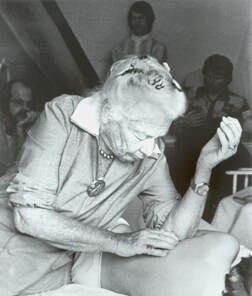Rolfing® Structural Integration (SI)

Rolfing® Structural Integration is a holistic bodywork discipline which, to this day remains a unique form of fascia therapy. The biochemist Dr. Ida P. Rolf, who created this work, conceived the breakthrough concept of integrating gravity into therapy. This is a key difference between Rolfing® SI and other methods of fascia therapy, that gravity provides the human body with a stressful, yet organizing force.
Rolfers™ refer to fascia as the “organ of structure".
In the mid 20th century Dr. Ida Rolf developed the theory that deliberate and targeted mobilization of the connective tissue – i.e. the fascia – leads to relief and wellbeing. For this reason she called the fascia the “organ of form”. Rolfing always addresses the entire organism and does not orientate itself according to single symptoms.
The goals:
Rolfing® SI takes into account gravity’s role in our health
Gravity affects us everywhere on earth and constantly creates a pull or push tension in our bodies. If the body has become unbalanced, it must compensate to remain upright. As a result, muscles and fascia can become constantly strained with high energy demands on the body. Slouching postures aimed at relieving pain after accidents or operations, and one-sided use cause the fascia to become ever more compact in certain areas of the body. They become viscous, lose elasticity and are “drier” than healthy connective tissue.
Through Rolfing the body can re-organize itself in relation to gravity. Ideally, in a standing position, every body segment’s center of gravity is organized above the segments below. In this state a person hardly needs any active muscle strength to stand upright because the anatomical integrity of the structure is aligned with gravity which provides supporting from the ground up. The tension forces in the body are in balance.
Rolfers™ refer to fascia as the “organ of structure".
In the mid 20th century Dr. Ida Rolf developed the theory that deliberate and targeted mobilization of the connective tissue – i.e. the fascia – leads to relief and wellbeing. For this reason she called the fascia the “organ of form”. Rolfing always addresses the entire organism and does not orientate itself according to single symptoms.
The goals:
- The tissue’s elasticity and lubrication are re-established.
- The body is realigned.
- Unnecessary tensions within the body-wide fascia network can be released.
- Discomfort stemming from sticky and viscous fascia is precluded.
Rolfing® SI takes into account gravity’s role in our health
Gravity affects us everywhere on earth and constantly creates a pull or push tension in our bodies. If the body has become unbalanced, it must compensate to remain upright. As a result, muscles and fascia can become constantly strained with high energy demands on the body. Slouching postures aimed at relieving pain after accidents or operations, and one-sided use cause the fascia to become ever more compact in certain areas of the body. They become viscous, lose elasticity and are “drier” than healthy connective tissue.
Through Rolfing the body can re-organize itself in relation to gravity. Ideally, in a standing position, every body segment’s center of gravity is organized above the segments below. In this state a person hardly needs any active muscle strength to stand upright because the anatomical integrity of the structure is aligned with gravity which provides supporting from the ground up. The tension forces in the body are in balance.
For whom is Rolfing® SI helpful?

Rolfing can be helpful to many. Rolfing’s main aim is to improve structure, posture, and movement.
This is why Rolfing makes sense for the following groups:
- individuals with chronic tension, one example being professions requiring single-sided body use
- persons with injuries or operations where posture compensations are needed to alleviate pain or where movement is restricted or limited
- women after pregnancy and birth
- performers such as actors, musicians, and dancers, wanting to expand their self-awareness and expression
- athletes and sports enthusiasts wanting to train more effectively, increase their performance, avoid overuse, recover more quickly and with less side-effects after injury
- anyone looking to increase their body awareness and seeking long-term improvement in quality of well-being.
Rolfing: the classic 10-Series
Dr. Ida Rolf developed a therapeutic series consisting of ten sessions. Throughout this series, posture and movement patterns are improved systematically:
- In sessions 1 through 3 the Rolfer™ primarily works on the superficial fascia layers. The goals: increased elasticity in the chest, freer breathing, a healthier orientation of the pelvis, rib-cage, and shoulder girdle, and a better organization of feet and legs.
- In sessions 4 to 7 Rolfers™ work on deeper fascia layers and the body’s organization around a vertical axis “the line”.
- In sessions 8 to 10 the body is aligned as a whole to improve balance and become more flexible. Problems that have not yet been completely solved are targeted in these sessions. Specific attention is payed to the joint work between Rolfer and client regarding body awareness and the way the client moves to ensure that changes last.
Bottom line
Rolfing® Structural Integration is holistic body work. It helps re-establish elasticity and lubrication to sticky and viscous fascia tissue and an upright posture. In a series of ten sessions Rolfers™ support their clients in improving their posture and movement patterns.
Source and more info visit www.rolfing.org

